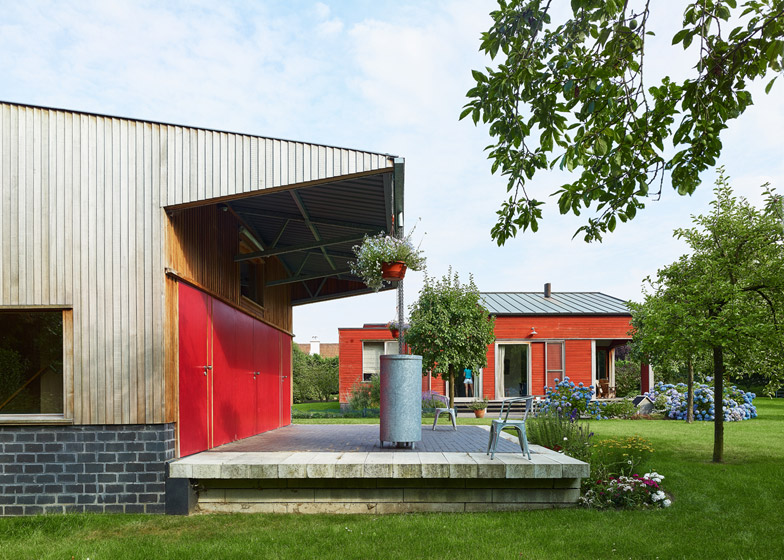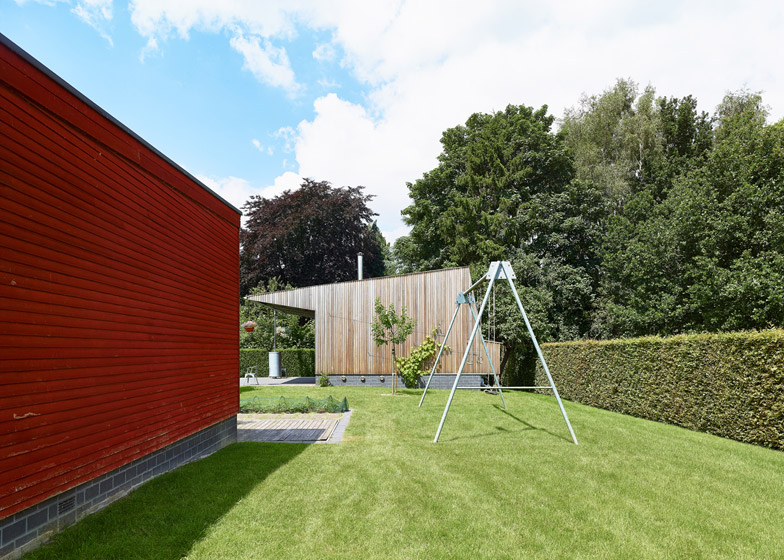Belgian studio De Smet Vermeulen Architecten designed this angular timber-clad cottage to create a music room in the garden of a house it designed over ten years ago near the village of Sint-Martens-Latem (+ slideshow).
De Smet Vermeulen Architecten completed the Braeckman-Staels property in 2000 and was later asked by its owners to work on an additional structure, situated at the edge of an orchard just outside.
The new building houses a toolshed, a chicken coop, a workshop and a music room where one of the clients' children can rehearse with her band.
The appearance of the original house references American ranches. According to the architects, its intersecting sloping surfaces were a reaction against the abundance of faux-vernacular architecture in this part of Belgium's Flanders region.
The new structure shares visual elements with the main house, including its angular form and a similar material palette, but certain details have been altered to give each building a distinct character.
"The cottage was designed to have the same general spirit as the house without being identical in style," architect Paul Vermeulen told Dezeen.
"Like buildings on a farmyard, each of them is built according to prevailing practical considerations but in keeping with a general idea of accordance."
A brick plinth supports a wooden-framed construction that has been cloaked in timber boards to evoke the cladding of the house.
However, while the exterior of the house is painted and its internal joinery is untreated, the inverse approach has been used in the cottage.
A slanted roofline that echoes the house's gently angled surfaces culminates in a pointed overhang above a patio area, which can be used as an external work space adjacent to the toolshed doors.
At the rear of the structure, the corrugated steel roof folds out over the top of a cantilevered section that provides a protected roost for the family's chickens.
Vertical surfaces on either side of the building have been painted red to contrast with the wooden boards while creating a connection with the tone of the main house.
Each of the rooms within the cottage is accessed by a dedicated entrance. This separation is reinforced by the lack of any internal connecting spaces.
One of the entrances leads to stairs that ascend to a hobby room with a large picture window set into the sloping wall. Another of the doors provides access to the concrete-lined cellar, which is used as a sound-insulated music room.
"Concrete was an obvious choice on the outside of the cellar," Vermeulen explained, "and we thought it was nice to show it on the inside as well. This is a sort of interior that the main house, having no cellar, does not have."
A wood-burning stove is situated in one corner of the cellar, while plywood panels covering parts of the walls enhance the heat and sound insulating properties of the space.
Both the hobby room and cellar incorporate ladders that ascend to small attics containing sleeping alcoves.
Photography is by Dennis De Smet.
Project credits:
Architects: De Smet Vermeulen architecten
Team: Henk De Smet, Nikolaj De Meulder, Paul Vermeulen












